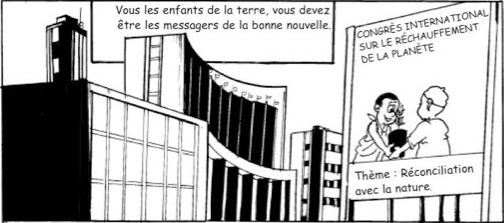
What’s behind Wise TeBe
Saturday, May 03, 2008
The adventures of « sagetebe» aim to re-establish a forest friendly attitude instead of today’s predominant trend towards forest abuse. The menace arising from the loss of forests and subsequent desertification involves us all, mainly when it comes to regions like Ivory Coast where the line between forest and Savannah , Savannah and desert, wealth and poverty is thinner than the limit represented by the 8th parallel (the government imposed limit for forestry exploitation). This limit takes its shape according to the attitude of those members of the « filière du bois », such as the ministry of waters and forests, forestry workers, timber companies, and farmers.
Despite nominal obligation by the Ivorian government since 1996, few forestry workers and timber companies have ever committed themselves to serious and professional reforestation efforts.
For several reasons, Ivory Coast can be used as a research laboratory where one can use the past 150 years to emulate the long term developmental processes already experienced by first world countries. This strategy has wreaked havoc on existing forests in Ivory Coast.
Global scale environmental organisations such Greenpeace have, perhaps justifiably, concentrated their safeguarding efforts on countries and regions like Gabon, Cameroon, South America, and East Asia. However, one should also prioritize the condition of microclimates at risk, because by solving these micro-problems we would have already solved a larger chunk of the global environmental issues.
One cannot speak about global warming without realizing that there are entire populations that could go from poverty into extreme need in the matter of only 2-3 generations. Here in Ivory Coast if one seriously studied the many factors driving the once lush forest into extinction, the remedies could then be studied as well.
Thanks to the existing measures we could truly learn how to reconstitute the ancestral forest in an already highly populated area. And, why not -- we could then even define some social development models from a pro-forest perspective. We could study what agricultural and breeding activities can be developed side by side with the forest. For instance, trees can help agricultural practices with both irrigation and soil enrichment.
These are only a few of the innovations that pushed my dear friend Gabriella Gaia and I to publish, with the help of the artist Yapo Martial, The Adventures of the Sage Tebe.
When we started the publications in 1999 in Adzope (our home town) there was not internet available, and even up to a few months ago surfing the web was impossible for people like us who work on the field and not in an office.
At the end of 2007 we got a DSL connection and I realized that there are many of us in the world with the same hopes and propositions.
I am hence convinced that, thanks to silviculture, to the reforestation, and to a new way for the "amenagement" of the forest, agriculture and breeding , we can really make some important changes.
We think that this comic can certainly be used as an instructive and social tool; we hope to divulge this "pro-foret" message mostly in schools and in the villages to sensitize the youth and the peasants given the lack of input from the main players.
In fact given the lack of external help, a change needs to start fundamentally from the bottom up. What better solution than to instruct kids and adolescents (the main players of tomorrow's world) to try to reverse the destructive tendency and to return to a pro-forest view. This could give the people a quality of life by now forgotten, and certainly better than what we can expect from the madness which characterizes our time.
TROPINI Riccardo

